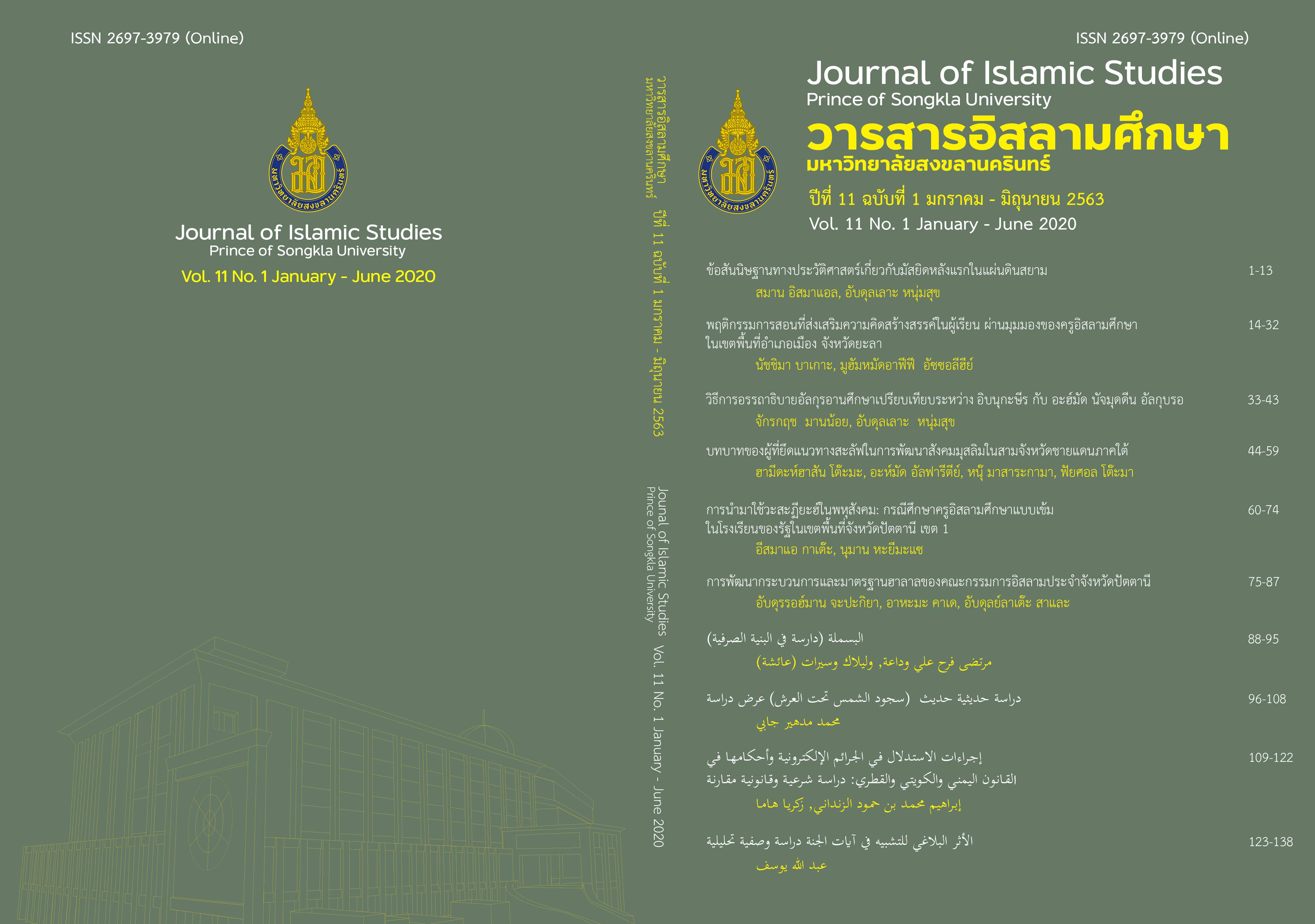พฤติกรรมการสอนที่ส่งเสริมความคิดสร้างสรรค์ในผู้เรียนของครูอิสลามศึกษาที่ปฏิบัติงานในโรงเรียนเอกชนสอนศาสนาอิสลาม ในเขตพื้นที่อำเภอเมือง จังหวัดยะลา
คำสำคัญ:
พฤติกรรมการสอน, ความคิดสร้างสรรค์, ครูอิสลามศึกษาบทคัดย่อ
การศึกษานี้มีวัตถุประสงค์เพื่อทำความเข้าใจสถานการณ์และการรับรู้ของครูอิสลามศึกษาที่มีต่อพฤติกรรมการสอนที่ส่งเสริมความคิดสร้างสรรค์ของผู้เรียน พฤติกรรมการสอนของครูอิสลามศึกษาและเงื่อนไขที่เกี่ยวข้องกับพฤติกรรมการสอนของครูอิสลามศึกษาที่ส่งเสริมความคิดสร้างสรรค์ของผู้เรียน การศึกษาใช้ระเบียบวิธีการวิจัยเชิงคุณภาพ โดยการสัมภาษณ์เชิงลึกครูอิสลามศึกษาจำนวน 9 คน ซึ่งทำการคัดเลือกแบบเจาะจงโดยมีเกณฑ์ในการคัดเลือก ผลการศึกษาพบว่า ครูอิสลามศึกษามีการรับรู้ต่อสถานการณ์ของพฤติกรรมการสอนที่ส่งเสริมความคิดสร้างสรรค์ของผู้เรียน ได้แก่ 1) ครูผู้สอนมีพฤติกรรมการสอนที่ยังไม่มีคุณภาพ 2) ครูผู้สอนเริ่มมีการพัฒนาในด้านการสอนแต่ยังไม่ดีเท่าที่ควร 3) ผู้เรียนเข้าหาครูสายสามัญมากกว่าครูสายศาสนา 4) ครูต้องการให้มีการปรับปรุงแก้ไขพัฒนาวิธีการสอนและด้านอื่น ๆ ที่เกี่ยวข้อง และสำหรับพฤติกรรมการสอนของครูอิสลามศึกษาที่ส่งเสริมความคิดสร้างสรรค์ในผู้เรียน ประกอบด้วย 1) พฤติกรรมด้านการสอน ได้แก่ การยกตัวอย่างประกอบการสอน การใช้สื่อภาพ เทคโนโลยีประกอบการสอน เป็นต้น 2) พฤติกรรมด้านการบริหารจัดการ ได้แก่ การเก็บคะแนนเป็นรายกลุ่ม การเข้าหาผู้เรียนนอกเวลาเรียน เป็นต้น และ 3) พฤติกรรมด้านอารมณ์และสังคม ได้แก่ การมีทัศนคติที่ดีต่อผู้เรียน การมีปฏิสัมพันธ์ที่ดีระหว่างครูผู้สอนและผู้เรียน เป็นต้น และสำหรับเงื่อนไขที่เกี่ยวข้องกับพฤติกรรมการสอน แบ่งออกเป็น 2 ด้าน ได้แก่ 1) ด้านตัวบุคคล ประกอบด้วย เป็นคนกล้าแสดงออก เป็นผู้ที่เรียนรู้และพัฒนาตนเองอยู่เสมอ เป็นต้น และ 2) ด้านสภาพแวดล้อม ประกอบด้วย วิชาที่สอนเอื้อต่อการเสริมสร้างความคิดสร้างสรรค์ การมีแบบอย่างด้านการสอน เป็นต้น
เอกสารอ้างอิง
จารุวัจน์ สองเมือง และธีรพงศ์ แก่นอินทร์. (2555). สภาพ ปัญหาและความต้องการของครูเพื่อการจัดการเรียนการสอนในโรงเรียนเอกชนสอนศาสนาอิสลาม. วารสาร AL-NUR, 7(13), 19-32.
ชลกร ตันประภัสร์, ธร สุนทรายุทธ และไพรัตน์ วงษ์นาม. (2556). ปัจจัยที่ส่งผลต่อความสร้างสรรค์และนวัตกรรมของโรงเรียนเอกชน ประเภทสามัญศึกษาระดับการศึกษาขั้นพื้นฐาน. วารสารการบริหารการศึกษา มหาวิทยาลัยบูรพา, 7(2), 42-55.
ทิพวัลย์ ปัญจมะวัต. (2548). ปัจจัยที่ส่งผลต่อความคิดสร้างสรรค์ของนิสิตระดับปริญญาบัณฑิต จุฬาลงกรณ์มหาวิทยาลัย (วิทยานิพนธ์ครุศาสตรมหาบัณฑิต). กรุงเทพมหานคร: จุฬาลงกรณ์มหาวิทยาลัย.
นฤมล ไกรฤกษ์. (2558). การพัฒนาความคิดสร้างสรรค์ของเด็กปฐมวัยปีที่ 2 โดยใช้กิจกรรมศิลปะต่างรูปแบบ โรงเรียนวัดดุสิตาราม (วิทยานิพนธ์ครุศาสตรมหาบัณฑิต). กรุงเทพมหานคร: มหาวิทยาลัยราชภัฏธนบุรี.
นิเพาซาน วาบา. (2556). การบริหารงานวิชาการในโรงเรียนเอกชนสอนศาสนาอิสลามจังหวัดปัตตานี (วิทยานิพนธ์ ครุศาสตรมหาบัณฑิต). สงขลา: มหาวิทยาลัยหาดใหญ่.
รุชดี สันนะกิจ. (2558). ภาวะผู้นำการเปลี่ยนแปลงของผู้บริหารโรงเรียนที่ส่งผลต่อการเป็นองค์กรแห่งการเรียนรู้ของโรงเรียนเอกชนสอนศาสนาอิสลาม สังกัดสำนักงานการศึกษาเอกชน จังหวัดสงขลา (วิทยานิพนธ์ครุศาสตรมหาบัณฑิต). สงขลา: มหาวิทยาลัยหาดใหญ่.
วรวุธ มัสพันธ์. (2556). ปัจจัยทางจิตสังคมที่ส่งผลต่อความคิดสร้างสรรค์ของนักเรียนช่วงชั้นที่ 2 ในโรงเรียนสังกัดกรุงเทพมหานคร (สารนิพนธ์การศึกษามหาบัณฑิต). กรุงเทพมหานคร: มหาวิทยาลัยศรีนครินทรวิโรฒ.
วิรัตน์ เหมรินี, รัชตา ธรรมเจริญ และปรีดา เบ็ญคาร. (2559). ปัญหาการใช้หลักสูตรอิสลามศึกษาของครูในโรงเรียนเอกชนสอนศาสนาอิสลามจังหวัดพัทลุง. ในการประชุมหาดใหญ่วิชาการระดับชาติ และนานาชาติ ครั้งที่ 7, 23 มิถุนายน 2559. สงขลา: มหาวิทยาลัยหาดใหญ่.
ศุกฤตา ภู่ระหงษ์. (2557). กิจกรรมส่งเสริมความคิดสร้างสรรค์โดยใช้แนวคิดทอร์แรนซ์ผ่านงานศิลปะ เรื่องวัฒนธรรมอาเซียน สำหรับนักเรียนชั้นประถมศึกษาปีที่ 5 (การค้นคว้าอิสระการศึกษามหาบัณฑิต). พิศณุโลก: มหาวิทยาลัยนเรศวร.
สถาบันทดสอบทางการศึกษาแห่งชาติ. (2560). ระบบรายงานผลการทดสอบทางการศึกษาแห่งชาติ (O-NET) ด้วยแผนที่ของประเทศไทย. กรุงเทพฯ: ผู้แต่ง.
สำนักงาน ก.พ. (2559). หนังสืออิเลกทรอนิกส์ การคิดเชิงสร้างสรรค์. นนทบุรี: ผู้แต่ง.
สำนักงานเลขาธิการสภาการศึกษา. (2560). แผนการศึกษาแห่งชาติ พ.ศ. 2560-2579. กรุงเทพฯ: ผู้แต่ง.
Garrison, K. C., & Magoon, R. (1972). Educational psychology. Ohio: Charles E. Morrill publishing century-crofts.
Hein, V. (2012). The effect of teacher behaviour on student’s motivation and learning outcomes: a review. Acta Kinesiologiae Universitatis Tartuensis, 18, 9-19.
Mackinnon, D. W. (1978). In search of human effectiveness: identifying and developing creativity. New York: Creative education foundation.
Mendelsohn, G. A., & Griswold, B. B. (1966). Assessed creative potential, vocabulary level, and sex as predictors of use of incidental cues in verbal problem solving. Journal of Personality and Social Psychology, 4(4), 423-431.
Miles, M. B., & Huberman, A. M. (1994). Qualitative data analysis: an expanded sourcebook. (2nd ed). Thousand oaks: Sage publication.
Nair, S., & Ngang, T. K. (2012). Exploring parents’ and teachers’ views of primary pupils’ thinking skills and problem-solving skills. Creative Education, 3(01), 30-36.
Osborn, A. F. (1963). Applied imagination. (3rd ed.). New York: Scribner’s.
Partnership for 21st Century Skills. (2008). 21st century skills, education & competitiveness: A resource and policy guide. AZ: Author.
Pössel P., Rudasill, K. M., Adelson, J. L., Bjerg, A. C., Wooldridge, D. T., & Black, S. W. (2013). Teaching behavior and well-being in students: Development and concurrent validity of an instrument to measure student-reported teaching behavior. International Journal of Emotional Education, 5(2), 5.
Schleicher, A. (2019). PISA 2018 insights and interpretations. Paris: Organization for economic co-operation and development (OECD).
Siedlaczek, K. (2004). Perceptions about teaching online versus in a classroom environment. College Quarterly, 7(3), 1-17.
Zemelman, S., Daniels, H., & Hyde, A. (2005). Best practice today’s standards for teaching and learning in America’s schools. (3rd ed.). Portsmouth, New Hampshire: Heinemann.
ดาวน์โหลด
เผยแพร่แล้ว
รูปแบบการอ้างอิง
ฉบับ
ประเภทบทความ
สัญญาอนุญาต
บทความทุกเรื่อง ที่ได้รับการตีพิมพ์ในวารสารอิสลามศึกษาเป็นแนวคิดของผู้เขียน มิใช่เป็นความคิดเห็นคณะผู้จัดทำและมิใช่ความรับผิดชอบของคณะวิทยาการอิสลาม กองบรรณาธิการไม่สงวนสิทธิ์การคัดลอก แต่ให้มีการอ้างอิงแสดงที่มา




